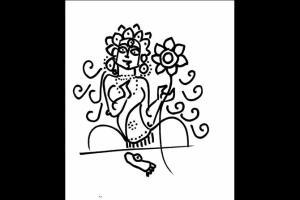Before this, the only goddess who was very prominent in Buddhist literature was Shri or the Goddess of fortune, clearly included within the Buddhist iconography by the lay people

Illustration/Devdutt Pattanaik
 A thousand years after the Buddha's nirvana, Buddhists finally acquired a goddess of (almost) equal stature to the Buddha. Before this, the only goddess who was very prominent in Buddhist literature was Shri or the Goddess of fortune, clearly included within the Buddhist iconography by the lay people.
A thousand years after the Buddha's nirvana, Buddhists finally acquired a goddess of (almost) equal stature to the Buddha. Before this, the only goddess who was very prominent in Buddhist literature was Shri or the Goddess of fortune, clearly included within the Buddhist iconography by the lay people.
However, a 1,000 years later, the need for a woman to be part of the Buddhist pantheon was felt greatly, and so emerged Tara.
ADVERTISEMENT
Tara's entry into the Buddhist pantheon was a very slow process. It began in many ways, with the rise in Mahayana Buddhism, about 500 years after the Buddha passed away. In this new school, people asked about the compassion of the Buddha, beyond his wisdom, and these conversations on compassion lead to the creation of a character known as Bodhisattva, someone who delays his nirvana, so that he could help people from their suffering. As these ideas emerged, the idea of compassion and wisdom came about, Buddha came to be associated with compassion and wisdom was given a female form, Tara.
In many ways, this Tara was linked to Vak, or Saraswati, the Vedic goddess of knowledge, and Shruta-devi, goddess of discourse in Jainism. In the eastern part of India, we find that the wild Kali is also called Tara, and she is invoked by Tantrikas for knowledge and power. Thus, Tara is an amalgamation of the goddess of knowledge and the goddess of power.
The earliest iconography of Tara as an independent Goddess comes to us from the Ellora caves, in the western part of India, roughly around 7th century, so 1,300 years ago. She is visualised holding a lotus flower, like Shri, for whom lotus embodies fortune, and like Padmapani, the compassionate lotus-holding Buddha, for whom lotus embodies wisdom.
Depending on which Buddhist literature you read, Tara is identified differently by different people. Some call her the mother of the Buddha. Some call her the daughter of the Bodhisattva because she was born from the tears shed by the Bodhisattva. Some call her the consort of the Buddha, especially Dhyani Buddha, the immortal Buddha. Some call her the embodiment of Avatilokeshwara, the Bodhisattva. In Vajra Yana Buddhism, she is also imagined as the female Buddha. Sometimes, she is just a metaphor, the embodiment of Bodhi-chitta or the wisdom that enables one to transform into the Bodhisattva.
Tara is seen sometimes as one and sometimes as two and sometimes as four and sometimes as a collective of 21 Goddesses. The most popular forms are the white Tara and the green Tara. The two are identified with the Chinese and the Nepalese wives of the Tibetan king, who introduced Buddhism into Tibet. The green Tara is associated with seven eyes, a third eye between the forehead and extra eyes in her palms and soles of her feet that enables her to hear people. The two are visualised as standing on his left and right sides, holding an un-bloomed and a bloomed lotus, for Bodhisattva listens to the cries of suffering people, day and night.
Tara is an important part of Buddhism but it is not part of the oldest school, Theravada Buddhism, practiced in south-east Asia, in Sri Lanka and Myanmar, where a greater importance is given to the historical Buddha.
The author writes and lectures on the relevance of mythology in modern times. Reach him at devdutt@devdutt.com
Catch up on all the latest Crime, National, International and Hatke news here. Also, download the new mid-day Android and iOS apps to get latest updates
 Subscribe today by clicking the link and stay updated with the latest news!" Click here!
Subscribe today by clicking the link and stay updated with the latest news!" Click here!







